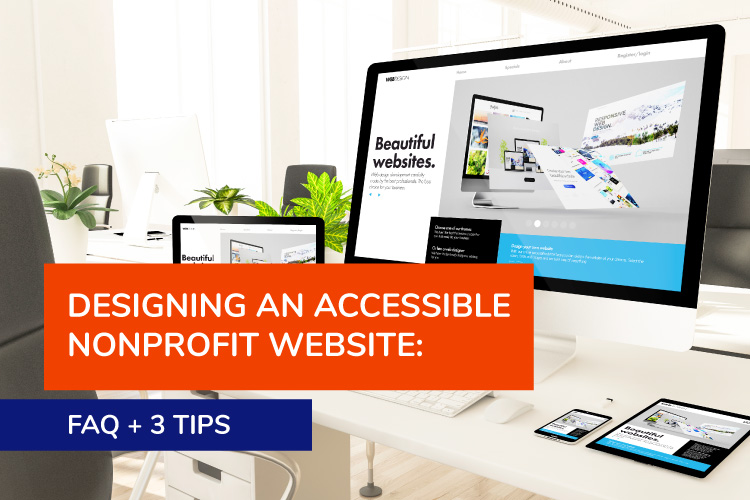Designing an Accessible Nonprofit Website: FAQ + 3 Tips

When you think about your nonprofit’s digital communication strategy, what comes to mind? You probably consider your social media presence, email marketing efforts, and maybe even text messaging. However, the core of this strategy is your organization’s website.
According to Loop, “A beautiful and well-crafted nonprofit website will draw your audience in, instill a sense of trust, and compel people to take action.” But you’ll only achieve these goals if everyone who visits your website is able to gain value from your content, including those with disabilities.
This is where website accessibility comes in. In this guide, we’ll answer some frequently asked questions about accessibility and share three top tips for designing an accessible website. Let’s dive in!
Nonprofit Website Accessibility FAQ
What is website accessibility?
Website accessibility is the process of ensuring equitable access to website content by people of all abilities. This includes but is not limited to making sites accessible for those with visual, auditory, physical, and neurological disabilities. Website accessibility can also be helpful for older audiences who may have more difficulty navigating online content and makes websites more user-friendly in general.
Why does accessibility matter for nonprofit websites?
The most notable reason to ensure website accessibility is that it’s often a legal issue due to its inclusion in the Americans With Disabilities Act (ADA) and other similar legislation. However, there are additional benefits your nonprofit can enjoy by designing an accessible website, including:
- More site visits. When more people have a positive experience interacting with your content, it’s likely that more of them will.
- Improved search engine optimization (SEO). Google’s algorithms tend to reward accessible websites by ranking them higher in search results, which increases your site’s visibility.
- Higher donor retention. According to NXUnite, a positive supporter journey is essential to keeping donors involved with your organization long term, and their experience using your website can play a major role in this journey.
- Showing that you prioritize inclusivity. Having an accessible website can also boost your nonprofit’s reputation as an organization that strives to include all members of your community.
Prioritizing website accessibility can not only help your organization avoid legal consequences but also expand your reach and solidify your commitment to promoting social good in a variety of ways.
What resources can my nonprofit use to make its website more accessible?
Your organization has a number of options when it comes to designing a new accessible website or improving accessibility on your existing site. For instance, you could:
- Evaluate various aspects of your website against industry-standard checklists such as the Web Content Accessibility Guidelines (WCAG) 2.1.
- Use a responsive web design framework that provides features to enhance user experience, including accessibility.
- Work with a nonprofit website design agency that understands the ins and outs of web accessibility.
No matter what resources you use, make sure you go into the accessible design process with a clear understanding of the improvements you need to make. To help you get started, let’s walk through three key strategies for creating an accessible website.
3 Tips to Improve Nonprofit Website Accessibility
1. Ensure Adequate Color Contrast
Effective use of color in website design is a balancing act. On the one hand, you need to stay true to your nonprofit’s brand to make your site recognizable and memorable for your audience. However, you should also ensure that your text colors contrast adequately with their background to improve readability, especially for visitors who experience low vision or color blindness.
The WCAG 2.1 checklist recommends color contrast ratios of 4.5:1 for regular copy and 3:1 for headings or large text. For many organizations, the use case where maintaining these ratios is most difficult is when a photo is used as the background for text, as the image’s color variations create inconsistent contrast. To solve this problem, place a color overlay on the photo so the text background is all one color.
Additionally, pay attention to your use of color when incorporating hover effects (i.e. visual changes that occur when a visitor moves their cursor over a clickable element) on buttons and hyperlinks. Rather than simply having the text change color, make the clickable element more noticeable through underlining, size changes, or movement.
2. Serve Media in Multiple Formats
Multimedia elements like infographics, audio recordings, and embedded videos can make your site more interactive for your audience. However, to engage all visitors, visuals should be made accessible for individuals who rely on screen reader technology, and content with an auditory element should have a textual counterpart for those who are hard of hearing.
To ensure these visitors can gain value from your multimedia content, include the following formatting elements on your website:
- Alternative text for images. When you upload a photo or graphic to the backend of your website, there should be an ALT field where you can enter a short description of the image (about 100-140 characters). A screen reader can then interpret the alt text, allowing the visitor using it to understand the purpose of the image.
- Transcripts of audio-only content. If your nonprofit uploads recordings of interviews or podcast episodes to your website, provide a full-text readout of the audio. There are a variety of transcription tools available online to make this process easier, but make sure to read and revise the transcript so it’s accurate and readable.
- Closed captions for videos. Closed captions translate the various sound elements of a video into text as a visitor is watching it. Make sure your closed captions are legible, and allow audiences to choose from multiple language options if the software allows.
Serving multimedia content in multiple formats can be helpful for visitors experiencing temporary accessibility issues as well. For example, closed captions allow audiences to understand your videos even if they watch them while in a location where they can’t turn up their device’s volume. Additionally, alt text will sometimes appear in place of an image if a visitor’s internet connection is too weak to load the photo or graphic.
3. Develop an Intuitive Navigation Structure
User-friendly website navigation is also essential to designing for accessibility. Your site menu should include all of the key pages on your site, such as your About page, contact form, and resources. The menu also needs to be easy to use on both desktop and mobile, and visitors with physical disabilities should be able to navigate through it using only a keyboard.
To test navigation, recruit a group of volunteers and ask them to complete different tasks on your website such as donating online or finding a specific blog article. Allow some volunteers to use a computer as they normally would, ask a few to try out your site’s keyboard navigation capabilities, and have the rest access the website on a tablet or smartphone. Ask for feedback from each volunteer after the test and consider it as you make any final usability improvements before launching your site.
After you implement these accessibility features on your nonprofit’s website, continue to monitor it and make adjustments as needed. Provide a space for general feedback as well—whether through your contact form or a separate survey—so you know if visitors find your site easy to use and gain value from it.


